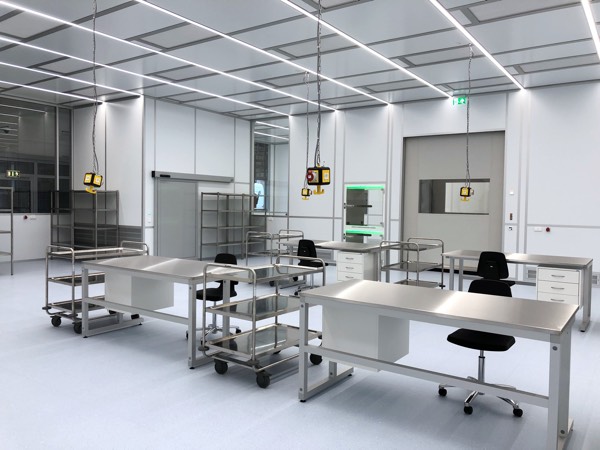A new 400 sqm ISO Class 6 cleanroom has started operation in Austria at Plansee, the Reutte-based company that specialises in powder processing of the hi-tech metals such as molybdenum and tungsten.
The new facility has been built with the latest technology provided by Schilling Engineering. The German cleanroom specialist said the new site has been put into operation meeting the high safety standards of the semiconductor industry.
With more than 14,000 employees at 50 production sites worldwide, the private company Plansee Group generated sales of €1.5 billion in the 2018/2019 financial year.
Plansee's headquarters, and the company's largest production site, are located in Austria, where the company originated in 1921. Today, Plansee focuses on high-melting metals with special properties, namely high resistance and good conductivity.
Clean metal processing
At Plansee, the metals are first processed into high-purity powder and then pressed and sintered. The semi-finished products and components are required in the electronics industry, in semiconductor manufacturing, and in medical technology. Absolute cleanliness in production, therefore, is a top priority.
The production of components for semiconductors takes place within a CleanCell4.0, Schilling's ISO Class 6 cleanroom workstation. Parts made of molybdenum and other materials are assembled inside, which could be impaired in their function by the smallest impurities.

Furniture and roller shutters with non-contact control ensure safe processes
Contamination of the sensitive components by particles must be absolutely ruled out. That is why over half of the 400 sqm production area meets the strict cleanliness requirements of ISO cleanroom Class 6.
Energy-efficient air circulation
Schilling explained that clean air is introduced into the cleanroom with the help of laminar flow units integrated into the ceiling, which are equipped with ULPA15 high-performance filters.
The particle-free airflow displaces airborne particles downwards and are then discharged from the cleanroom into the air circulation system. This air exchange process is carried out up to 60 times an hour.
Recirculation and return air is routed within the cleanroom walls. The already cooled and filtered air is circulated, which contributes to the efficient operation of the cleanroom, Schilling claims. In addition, the airflow within the walls ensures optimal use of space.
Commenting on why Plansee has chosen Schilling's cleanroom workstation, project manager Mario Kuisle, said: “The air circulation of the CleanCell4.0 cleanroom system convinced us from the start. This will enable us to save high energy costs in the long run. Another important factor was the fact that the airflow inside the walls ensured optimal use of space. The cleanroom was adapted precisely to our conditions.
The project was challenging due to the particular conditions of the site for which Schilling delivered a tailored solution. Kuisle explained: “The onsite ceiling of the Plansee hall is structurally unsuitable for suspension due to the expected snow loads, among other things. Subsequently, the cleanroom ceiling was constructed using a self-supporting framework made of aluminium profiles.
"The ceiling is accessible and has been marked with stable walking paths. A huge advantage of the construction is that the cleanroom was built without supports and columns," he added.
Modular design
For Schilling, another challenge was the required height of the cleanroom, which was designed to be four meters higher than normal sites. The height required by the installation of measuring machines could be achieved with removable wall elements.
The ceiling, which is equipped with 67 clean air units, has a modular structure and can be flexibly redesigned. For Schilling, the modular system of the CleanCell4.0 cleanroom enables flexible planning of future utilisation.

The intelligent lighting on material locks and doors takes flushing times into account and indicates when a door can be opened
"The modular design of the cleanroom system helped us significantly in our investment decision," Kuisle said. "We wanted to be able to quickly and flexibly convert the cleanroom to other production processes. We are currently producing for semiconductor production and have integrated the production machines into the cleanroom walls. Thanks to the modular wall and ceiling elements, we can convert to changing allocation concepts in the future."
Cleanroom lighting
In the Plansee project, intelligent control dimmable LED light strips were integrated homogeneously into the aluminium strips of the ceiling. Featuring 1000 lux, these LEDs achieve uniform lighting with little shade and contribute to energy savings, Schilling said.
Doors and material locks are also illuminated with LEDs. The design uses various colours to help visualise whether a door can be opened or must remain closed for pressure compensation and active flushing.
Schilling also revealed that the monitoring system chosen for this project offers intelligent control of production-relevant room data, such as temperature and humidity.
The high-precision air-conditioning technology temperates the room with a deviation of +/- 1 °C and is also characterised by extremely energy-efficient air conditioning.
For Kuisle, the cleanroom runs flawlessly. "The technology is very complex but perfectly coordinated and well thought out," he said.
For both Schilling and Plansee, the energy optimisation of the cleanroom was very important to the project. "Using a heat pump, we can save high additional costs in the long term. We also have the option of programming a night-time reduction. The quiet filters and good lighting are also very positive, which facilitates the daily work in the cleanroom,” Kuisle concluded.




